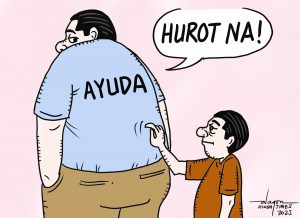By Severino C. Samonte
WHEN PRESIDENT Ferdinand R. Marcos Jr. pitched for federalism during a recent gathering of his party mates in the Partido Federal ng Pilipinas (PFP), he might have been thinking of a new fundamental law of the land somewhat similar to the 1973 Constitution.
“The Philippines has taken the first step toward a federal form of government that would make the country’s political structure more stable,” he said during the oath-taking of the new PFP officials and members in Malacañang.
“The seemingly federal setup will continue by bringing more power centers to other parts of the country. That is very simple. That derives from a very simple idea that the stability of a political structure is much more reliable when we have many power centers. If the power centers belong only here in Manila, then if Manila falls, the entire Philippines would fall,” he explained.
“And that’s why the idea of federalism becomes very important because, again, it is my firm belief that we really have to give. What I always say, which is very, very much in parallel with the thinking of federalism, is that with all the systems that we are trying to put together, what we are trying to do is to make the decision process be made at as low a level as possible.”
The statement of the President, as reported by the Philippine News Agency (PNA) on Aug. 24, prompted this writer to look back at the establishment under the 1973 Constitution of a “modified parliamentary form of government believed to be suitable to the temperament of the Filipino people at that time.”
The 1994 Philippine Yearbook published in 1995 by the National Statistics Office (now Philippine Statistics Authority or PSA) said under Republic Act 6132, also known as the 1971 Constitutional Convention (ConCon) Act, some 300 delegates from all over the country convened on June 1, 1971 to draft a new Constitution to replace the 1935 Charter.
The ConCon was first chaired by former President Carlos P. Garcia and then by former President Diosdado P. Macapagal upon the former’s death in June 1971.
The draft charter was approved on Nov. 29, 1972, exactly 18 months after the inaugural session and two months after the promulgation of martial law nationwide by then President Ferdinand E. Marcos on Sept. 21, 1972.
The new Constitution was ratified by the Citizens or barangay assemblies in a plebiscite on Jan. 10 and 15, 1973 and was put in full force two days later by Presidential Proclamation No. 1102.
The 17-Article 1973 Constitution shifted the Philippine government system from presidential to a modified parliamentary in the second half of the 1970s.
Section 1 of Article XVII (Transitory Provisions) of the Charter provided that “there shall be an interim National Assembly which shall exist immediately upon the ratification of this Constitution and shall continue until the members of the regular National Assembly or Batasang Pambansa shall have been elected and assumed office.”
In the modified parliamentary form of government, the president was assisted by the prime minister and members of the Cabinet with close links with the legislative body, then called the Batasang Pambansa.
The close relationship between the executive and the legislative branches of government was perceived to be a deterrent to constant deadlocks in the enactment of important and urgent laws, and would guarantee smooth operations of the government hierarchy.
The 1973 Charter was in force for 13 years — from Jan. 17, 1973 to March 25, 1986. It was superseded by the present 1987 Constitution promulgated by the administration of President Corazon C. Aquino after the Feb. 22-25, 1986 People Power Revolution.
The draft of the 1987 Constitution was prepared by 48 delegates appointed by President Aquino and chaired by retired Supreme Court Associate Justice Cecilia Muñoz-Palma. It was approved on Oct. 12, 1986, ratified in a plebiscite on Feb. 2, 1987 and went into full force immediately.
It abolished the Batasang Pambansa and restored the country’s bicameral Congress featured by the House of Representatives and the Senate which ceased to function with the promulgation of the 1973 Constitution in January of the same year.
The first congressional elections for the restored bicameral legislature were held on May 11, 1987.

